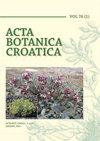Centaurea kilaea(菊科,Cardueae)的生殖生物学--土尔其特有种
IF 1.1
4区 生物学
Q3 PLANT SCIENCES
引用次数: 0
摘要
本研究使用光学显微镜研究了土耳其特有物种千叶仙人掌(Centaurea kilaea Boiss.)的胚胎学。千屈菜(C. kilaea)的花药为四孢子囊;花药壁的发育为双子叶;绦膜为变形体。小孢子母细胞的减数分裂是有规律的,当花粉粒从花药中抛出时,它们是三细胞的。千屈菜的子房下位,双心皮,合心皮,单室,这是菊科植物的特征。它只有一个胚珠,基部胎座。胚珠为倒生、单胚珠、腱状。巨型子囊母细胞进行减数分裂,产生线状四分体的巨型子囊。卡拉扎尔巨型孢子保持功能,其他三个巨型孢子迅速退化。有功能的巨型孢子依次进行三次有丝分裂。结果形成了一个有八个细胞核和七个细胞的蓼属胚囊。反节细胞一直持续到合子的第一次分裂。在成熟胚囊阶段,胚膜由内皮、内皮周围区域、实质细胞和外表皮组成,由内而外。胚乳的发育最初是游离核的,在球胚阶段变成细胞的。胚的发育是星状的。成熟的种子不含胚乳,但内皮层仍然存在。本文章由计算机程序翻译,如有差异,请以英文原文为准。
Reproductive biology of Centaurea kilaea (Asteraceae, Cardueae) – an endemic species from Türkiye
In this study, the embryology of Centaurea kilaea Boiss., a species endemic to Türkiye, was examined using light microscopy. The anthers of C. kilaea are tetrasporangiate; the anther wall development is dicotyledonous; and the tapetum is amoeboid. The meiotic division of the microspore mother cells is regular, and when the pollen grains are thrown from the anthers, they are three-celled. The ovary of C. kilaea is inferior, bicarpellary, syncarpous, and unilocular, which is characteristic of the Asteraceae family. It carries only a single ovule with basal placentation. The ovule is anatropous, unitegmic, and tenuinucellate. The megaspore mother cell undergoes meiotic division, giving rise to a linear tetrad of megaspores. The chalazal megaspore remains functional, and the other three megaspores degenerate rapidly. The functional megaspore undergoes three mitotic divisions in succession. As a result, a Polygonum-type embryo sac, with eight nuclei and seven cells, is formed. The antipodal cells persist until the first divisions of the zygote. In the mature embryo sac stage, the integument consists of the endothelium, peri-endothelial region, parenchymatous cells, and outer epidermis, from the inside out. Endosperm development is initially free nuclear, becoming cellular in the globular embryo stage. Embryo development is of the asterad type. The mature seed does not contain endosperm, but the endothelium persists.
求助全文
通过发布文献求助,成功后即可免费获取论文全文。
去求助
来源期刊

Acta Botanica Croatica
PLANT SCIENCES-
CiteScore
2.50
自引率
0.00%
发文量
34
审稿时长
>12 weeks
期刊介绍:
The interest of the journal is field (terrestrial and aquatic) and experimental botany (including microorganisms, plant viruses, bacteria, unicellular algae), from subcellular level to ecosystems. The attention of the Journal is aimed to the research of karstic areas of the southern Europe, karstic waters and the Adriatic Sea (Mediterranean).
 求助内容:
求助内容: 应助结果提醒方式:
应助结果提醒方式:


